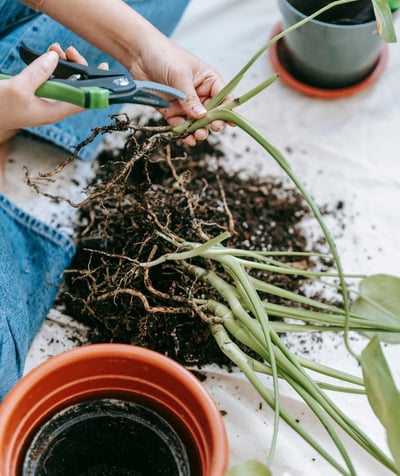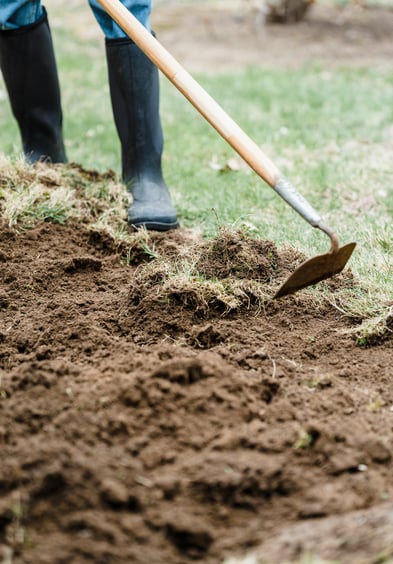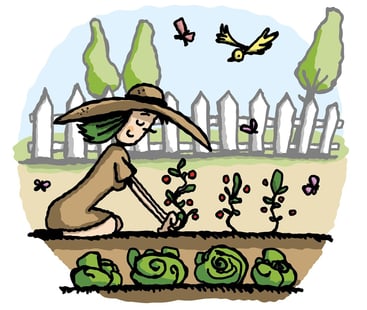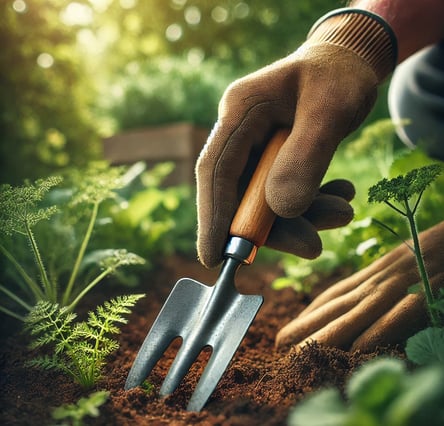Gardening 101: Essential Tools Every Beginner Needs
In "Gardening 101: Essential Tools Every Beginner Needs," we break down the must-have tools to kickstart your gardening journey. Whether you’re planting a few herbs on your balcony or transforming your backyard into a vibrant garden, having the right tools is essential. This guide covers everything from hand trowels to watering cans, helping you choose the best equipment for your gardening tasks. With practical tips and useful visuals, you’ll feel confident and prepared to dig into your new gardening adventure! Join us as we explore the tools that will make your gardening experience enjoyable and successful.
GARDENING BASICS
11/2/20249 min read


Starting a garden can be exciting, but with so many tools out there, it’s hard to know where to begin. Luckily, you don’t need to buy everything at once! Here’s a list of the essential tools that will set you up for gardening success.
1. Hand Trowel
A hand trowel is a small but powerful tool for digging, planting, and transferring soil. It’s perfect for small spaces, raised beds, and container gardening.


When choosing a good hand trowel for gardening, keep these points in mind:
Blade Material: Look for a rust-resistant material like stainless steel or carbon steel. These metals are durable and make it easier to dig into tough soil.
Handle Comfort: Choose a trowel with an ergonomic or padded handle that fits comfortably in your hand, especially if you’ll be using it for extended periods.
Blade Shape: A narrow, pointed blade is ideal for precise digging in tight spaces, while a broader blade works well for moving larger amounts of soil.
Solid Construction: A trowel with a single-piece construction (blade and handle) will be sturdier and less likely to bend or break.
By picking a hand trowel with these features, you’ll have a reliable tool that makes planting and weeding easier!
2. Garden Gloves
Quality gloves protect your hands from dirt, thorns, and blisters, making long hours in the garden comfortable and safe.
When selecting garden gloves as a beginner, here are a few key points to consider:
Material: Choose gloves made of durable, flexible materials. Leather gloves offer strong protection against thorns and sharp objects, while synthetic options like nitrile-coated gloves provide a good balance of flexibility and water resistance for everyday tasks.
Fit and Comfort: A snug fit is important for control and comfort. Look for gloves that fit well without being too tight, as overly loose gloves can cause blisters and reduce dexterity. Many gloves come in various sizes—try a few to find the right fit.
Grip: Good gloves will have a textured or coated grip on the palm and fingers. This feature is helpful for handling tools, pulling weeds, and carrying wet or slippery items without slipping.
Breathability: Gardening can get sweaty, so look for gloves with breathable fabrics or mesh inserts, which will keep your hands cool and comfortable during long gardening sessions.
Purpose: For general gardening tasks like planting and weeding, lightweight gloves are ideal. If you'll be working with thorny plants or handling heavy materials, opt for heavy-duty gloves for extra protection.
Choosing the right gloves will make gardening more enjoyable and protect your hands from blisters, cuts, and dirt.


3. Watering Can or Hose
Watering is key to a healthy garden, so a sturdy watering can or a flexible garden hose is a must-have. Choose a watering can with a narrow spout for targeted watering, or use a hose with an adjustable nozzle for larger areas.
### Choosing a Watering Can
Capacity: For small gardens or indoor plants, a smaller 1–2 liter can is easy to handle. For larger gardens, a 5-liter or more can reduce the number of refills.
Material: Plastic cans are lightweight and affordable, but metal cans (especially galvanized ones) are more durable and last longer. Be sure it’s rust-resistant if kept outdoors.


Spout Type: A long spout offers precise watering, ideal for reaching the base of plants. A detachable sprinkler head is also helpful, allowing you to switch between a gentle shower for seedlings and a steady stream for established plants.
Handle Design: Look for a can with a comfortable, well-positioned handle that allows for easy carrying and pouring.
### Choosing a Garden Hose
Length: Measure the distance from your water source to the farthest part of your garden. Buy a hose slightly longer than this to ensure coverage without overstretching.
Material and Durability: Rubber hoses are more durable and flexible but can be heavier. Vinyl hoses are lightweight and budget-friendly but may kink or wear out faster.
Diameter: Standard garden hoses are 1/2, 5/8, or 3/4 inches in diameter. A larger diameter provides more water flow, which is useful for larger gardens.
Nozzle Options: Look for a hose with an adjustable nozzle. Multi-setting nozzles allow you to switch between mist, jet, and shower settings, giving you more control based on your plants' needs.
Storage and Maintenance: Consider hose reels or holders to store your hose neatly, reducing wear and tangling.
With these tips, you’ll be able to choose a watering can or hose that suits your garden’s size and needs, making plant care more effective and enjoyable!


4. Pruning Shears (Secateurs)
Pruning shears are essential for cutting back plants, trimming stems, and removing dead growth. Here’s a quick guide to picking a good pair:
Types: For beginners, bypass shears are the best choice. They make clean cuts on green stems, unlike anvil shears, which are better suited for dry branches.
Blade Material: High-carbon steel blades are sharp and durable but need maintenance. Stainless steel is rust-resistant and low-maintenance.
Comfort: Look for ergonomic handles and a spring mechanism that reduces hand strain. A soft, non-slip grip will help with extended use.
Size & Weight: Choose a lightweight model that fits your hand comfortably, ideally with a blade length under 1 inch for finer cuts.
Maintenance: Some shears come with replaceable blades and sap grooves, making upkeep easier.
For beginners, mid-range shears around $20-$50 often offer the best balance of quality and comfort. Popular brands include Fiskars and Corona for their reliable, user-friendly designs.


5. Garden Fork
A garden fork is great for breaking up soil, removing weeds, and mixing compost into the ground. Opt for a sturdy, durable fork with strong tines.
6. Hoe
For larger garden spaces, a hoe is essential for loosening soil, removing weeds, and preparing planting beds. There are various types, but a simple draw hoe is versatile and beginner-friendly.
Picking the right hoe can make a big difference in the garden. Here’s what to consider:
Type:
Draw Hoe: Versatile for breaking up soil, digging, and cutting weeds.
Scuffle Hoe: Designed to slice weeds just below the surface with minimal effort—ideal for regular maintenance.
Blade Material:
Steel Blades: Durable and effective for tough soil and frequent use.
Stainless Steel: Rust-resistant and easier to clean, though may be slightly more expensive.
Handle Length:
Long Handle: Reduces the need to bend, minimizing back strain. Opt for a handle that reaches hip height for the best leverage.
Short Handle: Good for tighter spaces or raised beds but may require more bending.
Weight:
Lightweight hoes are easier for beginners to control and reduce fatigue, especially during longer tasks.
Grip:
Look for cushioned or ergonomic grips to prevent hand strain. A non-slip grip will also provide better control, especially in hot or wet conditions.
Here’s how to select the right one:
Type:
Digging Fork: Ideal for loosening heavy soil and aerating the ground, featuring thicker, sturdier tines.
Border Fork: Smaller and lighter, perfect for tight spaces and delicate tasks like transplanting.
Material:
Stainless Steel Tines: Rust-resistant and easy to clean, ensuring longevity and performance.
Carbon Steel Tines: Strong and durable but may require maintenance to prevent rust.
Handle:
Wood Handles: Traditional and comfortable but may need periodic maintenance.
Fiberglass Handles: Lightweight and durable, often providing better grip and less fatigue during use.
Tine Shape:
Look for flat tines for heavy digging and aerating. Curved tines can help scoop soil and compost.
Length:
Choose a handle length that allows you to work comfortably without bending too much. A longer handle provides better leverage for digging tasks.




Choosing a hoe with these features will make it easier to weed, dig, and maintain your garden with less effort and greater comfort.
By considering these factors, you can choose a garden fork that suits your gardening needs and helps make your tasks easier and more enjoyable!
7. Garden Rake
A garden rake is ideal for leveling soil, spreading mulch, and clearing debris. It’s a handy tool for both planting beds and larger garden areas.


When choosing one, consider these key factors:
Type: A bow rake (also called a soil rake) is ideal for heavy-duty tasks like leveling soil and spreading mulch. It has short, sturdy metal tines and is perfect for digging into tougher ground. For lighter tasks like gathering leaves, a leaf rake with flexible, fan-shaped tines is a better choice.
Material: Look for steel tines on a bow rake, as they’re durable and can handle tougher tasks without bending. Leaf rakes often come with plastic or metal tines, with metal being more durable but heavier.
Handle: A lightweight, long handle helps prevent strain on your back by allowing you to stand up straight while raking. Wooden handles are comfortable but heavier, while fiberglass or aluminum handles are lighter and often easier for beginners to handle.
Width: For larger areas, a wide rake head covers more ground quickly. For tighter spaces, a narrower rake offers more control.
Choosing a rake that suits your needs and is comfortable to handle will make garden maintenance easier and more enjoyable!
8. Garden Kneeler or Pad
Gardening often involves kneeling, so a garden kneeler or kneeling pad will protect your knees and make the work more comfortable. Look for a durable, waterproof option.
A garden kneeler or pad is essential for reducing strain on your knees and making gardening more comfortable. Here’s how to choose one:
Cushioning: Look for a pad that has thick, high-density foam to provide ample support for your knees, especially on hard ground. Memory foam options are excellent for extra comfort, while firm foam gives good stability.
Material: Ensure the material is water-resistant and easy to clean, as gardening often involves dirt and moisture. Some pads come with a waterproof cover, which helps extend their life.
Portability: Lightweight pads or kneelers with a built-in handle make it easy to carry around the garden. Foldable kneelers are also popular, as they’re compact and convenient to store.


Dual Purpose: Some garden kneelers double as a seat. These have a frame that allows you to flip the kneeler over and use it as a small bench—perfect for tasks that require sitting, like pruning or potting.
Durability: Opt for a kneeler or pad that’s built to last. Strong stitching and high-quality materials can ensure it withstands repeated use and exposure to the elements.
9. Wheelbarrow
A wheelbarrow makes moving soil, plants, and other materials easier. For smaller gardens, a compact model works well, while larger gardens may benefit from a bigger, heavy-duty wheelbarrow.
Here’s what to consider when choosing one:
Size and Capacity: For small gardens, a lightweight, compact wheelbarrow with a 2-3 cubic foot capacity is usually enough. Larger gardens or heavy-duty tasks may require a bigger, sturdier model.
Material: Choose between steel and plastic. Steel wheelbarrows are durable and can handle heavy loads, but they’re heavier and may rust. Plastic models are lightweight and won’t rust, but they’re better suited for lighter loads.


Wheels: Single-wheel models offer easy maneuverability in tight spaces, while two-wheel or four-wheel designs are more stable, reducing the risk of tipping—especially helpful for beginners.
Handles: Look for comfortable, well-padded handles. Ergonomic handles can make pushing and lifting easier, especially for heavier loads. Some wheelbarrows come with loop handles for added grip and control.
Weight: If you’re new to gardening, a lightweight wheelbarrow will be easier to handle, especially on uneven terrain.
Choosing the right wheelbarrow can make transporting materials simpler and safer, letting you enjoy gardening without unnecessary strain. Look for a balance of durability and comfort to make gardening tasks easier.
10. Hand Weeder
A hand weeder is a small, precise tool for removing weeds at the root. It’s especially useful for tight spaces and around delicate plants where larger tools might cause damage.
Here’s what to look for when choosing one:
Type of Weeder: For typical weeds, a dandelion weeder with a V-shaped tip is highly effective at gripping roots. Cape Cod weeders have a flat blade for slicing weeds just below the surface, which works well for soft soil. Choose based on the type of weeds you encounter.
Material: Opt for a hand weeder made of stainless steel or forged steel to ensure it resists rust and maintains its sharpness over time. A high-quality metal blade or tip will be more durable, especially for rocky or compact soil.
Handle Comfort: A comfortable, ergonomic handle is essential for reducing strain during long weeding sessions. Look for padded or soft-grip handles that fit well in your hand. Some weeders come with an extended handle to help you weed without bending too much.


Putting It All Together: The Essential Starter Kit
With these essential tools, you’re ready to begin your gardening journey. Start with a few basics, and as you gain experience, you can add specialized tools as needed. Happy gardening!
Leverage: A good hand weeder should offer some leverage to pry out deep roots easily. Weeders with a curved base or longer shaft help you gain extra force when removing tough weeds.
A well-chosen hand weeder makes tackling weeds easier and less strenuous, keeping your garden beds tidy with minimal effort.